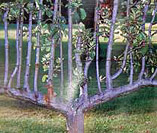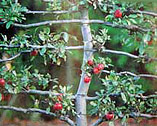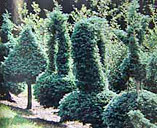The following article appeared in Garden Design magazine for May/June 1993
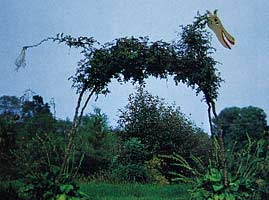
By Cheryl Weber/Photos by Felix Rigau
A witty horticulture sprouts in a garden in Honeybrook, Pennsylvania, in the heart of Lancaster County's fertile farmland. From Route 10 north, past the Amish tourist traps and tasseled cornfields, a rural road turns left at King’s Picnic Tables and descends to where Simple’s Nursery is tucked into trees.
Simple is a soft-spoken, puckish man with intense, dark eyes and black hair pulled into a ponytail. Over a span of two decades this self-taught artist/nurseryman has created a slightly surreal garden combining strangely shaped plants and recycled objects.
He goes simply by "Simple," a nickname that has stuck since high school. He hated school and dropped out, but kept the name, fancying the mystery that surrounds it.
"It brings a smile to people's faces," he says. "I don't want anyone to know my real name so I can be myself without being bothered."
In Simple's mind no shrub or tree is complete until he has turned it into something else. There is a 10-foot giraffe at the end of the driveway. Its elongated body is fashioned from the bent branches of Zanthoxylum simulans a woody shrub with reddish-brown fruit.
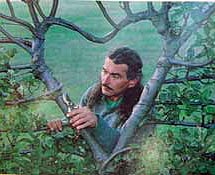 Along the drive stand 18 espaliered apple, pear, and cherry trees. Simple trained some of them into his trademark heart shapes, using wires to separate the trunks and to pull out the side shoots.
Along the drive stand 18 espaliered apple, pear, and cherry trees. Simple trained some of them into his trademark heart shapes, using wires to separate the trunks and to pull out the side shoots.
Simple's gardens have evolved piece by piece since 1978, when he started a nursery on five acres. He propagated most of the plants on the property, and learned landscaping by taking night classes at the nearby Pennsylvania Horticulture Society. From there he moved into a world of his own.
Simple delights in junk and little jokes. At the gateway he cut out a square of yew hedge and replaced it with an old glass window. He likes the way a Kentucky coffee tree casts morning shadows through the panes.
"People look, but don't see things," he says. "So I always do something unexpected."
An arching blue atlas cedar frames the "carriage house," actually a garage whose facade is cleverly redone to look like a quaint house. The horizontal lines of siding, recycled from a log cabin, and a large mound planted with liriope and ajuga "ground" the house visually, so it appears to nestle into the landscape. In spring, yellow-flowered bulbs push through the burgundy ajuga.
The carriage house is where Simple makes and sells the tromp l'oeil trellises and offbeat objects that inhabit the garden. They make the average stone gnome look lifeless by comparison. The "unscented" cow flops—a slice of local life—are 94 cents plus tax.
"The Amish love them," he says. "The ladies came through and couldn't stop laughing."
Crude creatures lurk throughout the garden, clinging to trees or burrowed under fallen leaves, waiting to spit on unsuspecting guests. They're made from water pipes and clothes hangers held together by caulking.
Marble for a square pond near the house was salvaged from a Philadelphia dumpster. Chamaecyparis filifera ‘Boulevard' "walls" around the fountain funnel water sounds to the dining terrace.
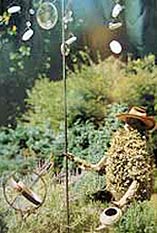 In an adjacent soggy depression, Simple planted carnivorous pitcher plants, then built a precarious plank path over the bog.
In an adjacent soggy depression, Simple planted carnivorous pitcher plants, then built a precarious plank path over the bog.
"My surprise element is the saggy planks," he says with obvious delight. "people are afraid they'll fall into the carnivorous plants."
Farther on, heavy steel pipes hang from tall trees like huge chimes. For shock value, Simple has positioned one as if it's just fallen, and a wine glass sits on a rock seat balanced between two trees.
"I always have places to sit and stage it with tea or wine glasses," Simple explains. "I live in my garden, not just look at it. I stage the garden so when people get into it, it comes to life."
His topiaries also bring the garden to life. Crocodiles, bears, bough seats, a dentist's chair and drill, and abstract, curlicued conifers are some of the unusual shapes that populate the back part of the property. He was turned on to topiary when Geraldine Lacey, a British horticulturist, gave a talk at nearby Longwood Gardens: Pat Hammer, former topiary specialist at Longwood, also was an inspiration.
"Both women were a big influence on my topiary," he says.
Though visitors gravitate to the topiary, the water-lily garden west of the house is where Simple spends his time. Fifteen feet long and 4 feet wide, with a 2-foot-deep pool, the slate terrace was designed for viewing from his bathroom window "so when I'm brushing my teeth I can see what's blooming," he says.
Like most artists, Simple is obsessive about his work. While brushing his teeth one day after the terrace was finished, he noticed it wasn't exactly centered between the trees.
"The next weekend I took the slate out, drained the pool, and moved it over 6 inches," he says. "From being a carpenter, I have a great eye.”
This is an evening garden, where the wispy inflorescences of huge grasses (Miscanthus gigantuem and Arundo donax) are backlit by the western sun. The tips on some are painted red to heighten the effect—Latex rubra, he calls them. Banana trees, bronze ajuga, red sedums, and golden creeping Jenny are planted in bold sweeps. It's the spot where Simple relaxes in the late afternoon.
"I love to drink gin under my banana trees while I'm feeding my fish," he says. "I'm a strong believer in happy hour. You must sit down and thank God before the second shift begins."
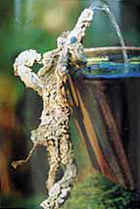 No area of the garden shows Simple's flair for fantasy and plant association better than the adjoining night garden. A low ring of bird's nest spruce (Picea abies 'Nidiformis') is punctuated by four pointy dwarf Alberta spruce (Picea glauca albertina 'Conica'). Inside the circle the garden erupts with textury mounds of artemisia, Russian sage, alliums, mint, catnip, achillea, and dianthus. It is presided over by the figure of a man softly landscaped with Euonymus fortunei ‘Emerald Gaiety.' He holds a can of water that spills into a small hole; a mobile of mirrored orbs dangles from a pole in the other hand. Lit at night, this garden is perhaps Simple's most sensory space.
No area of the garden shows Simple's flair for fantasy and plant association better than the adjoining night garden. A low ring of bird's nest spruce (Picea abies 'Nidiformis') is punctuated by four pointy dwarf Alberta spruce (Picea glauca albertina 'Conica'). Inside the circle the garden erupts with textury mounds of artemisia, Russian sage, alliums, mint, catnip, achillea, and dianthus. It is presided over by the figure of a man softly landscaped with Euonymus fortunei ‘Emerald Gaiety.' He holds a can of water that spills into a small hole; a mobile of mirrored orbs dangles from a pole in the other hand. Lit at night, this garden is perhaps Simple's most sensory space.
"The garden is very trippy at night," Simple says. "Uplighting reflects on mirrors and reflections float around; light catches your peripheral vision. It catches you off guard so many times—you don't know what it is. When the sun sets, the mirrors throw rainbows and you get a lot of colors. I always tell people, when the light reflects in your eyes, make a wish. I've gotten letters from people saying their wish came true. I was only kidding, but who's to say what's what?"
If dramatic lighting lures friends to the garden, music makes them stay. It's a component Simple takes seriously. Wooden birdhouses mounted throughout the property conceal stereo speakers. "I can operate five zones of sound for parties," he says. "I don't like the music sounds to bleed into one another."
There's a place for people of every musical persuasion. Blues accompanies beer in the loop house, he explains, "where the macho guys hang out." There's dance music in the main house, cowboy music in the garage, and classical music by the lily pond. On the eating terrace, he says it's "upbeat music to chat by." Simple's Halloween parties "are for people from different chapters of my life," he says. "If I lose touch, they always come back for the parties."
Simple held his final Halloween party last year. All gardens are ephemeral, and this one, too, is being dismantled as he moves on to other pursuits. "There's no way I can leave this behind," he says sadly. "The maintenance would be unbearable." Though the move is bittersweet—he and his wife are separating after 20 years—he is philosophical about it.
"When I began propagating in my basement, I never imagined it would turn into something this big," he says. "I like giving people ideas. I love it when the Longwood students come here and say, ‘Wow, it can be done that way, can't it?'”
This summer Simple plans to leave his hometown, hoping to teach horticultural art elsewhere. Just as his original creation has brought its crazy joy to so many in its lifetime, his horticultural peculiarities surely will pop up again in other forms, in future gardens.
Cheryl Weber is a senior editor for Garden Design.
return to about simple
